| Article ID | Journal | Published Year | Pages | File Type |
|---|---|---|---|---|
| 1735014 | Energy | 2010 | 9 Pages |
Accurate calculation of the heat transfer rate across building blocks may lead to significant energy savings. Conjugate heat transfer analysis is carried out numerically to compute the heat transfer rate/R-value as the number/layout of air-filled cavities is changed. Conduction heat transfer in the block material and both natural convection and radiation in the cavity were considered. It is found that increasing the number of cavities keeping the block width unchanged decreases the heat flux significantly. Five cavities can fit the building block under investigation without compromising the strength. Furthermore, changing the surface emissivity can increase the R-value substantially so that no insulation would be needed to fill the spaces. Thermal radiation plays a considerable role in the heat transfer process of this application. Through this study, the heat transfer characteristics and the gains in the R-value were quantified for the basic blocks used in the local market. Furthermore, the gains in the R-value were calculated for different number of cavities, for different cavities layouts for the conjugate contribution of conduction, convection and/or radiation across the building block. Results are useful for designers and manufacturers of building blocks for better energy savings of end users.
